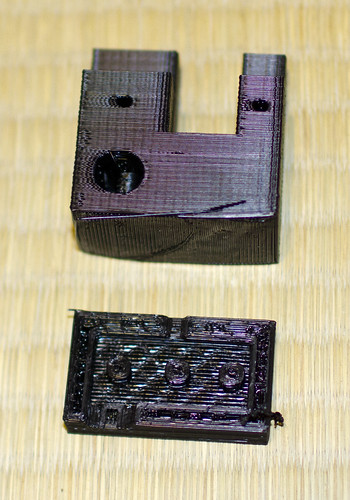I wanted to make a sturdy-but-hollow manifold for the air assist on my lasersaur. I ended up using a trick I’ve seen in catacombs and gothic structures — internal support columns.
The STL and images are posted over on thingiverse. The short of it is:
- make a hollow object
- determine which way will be up/down when you print it
- add columns along this axis that are close enough together and to the edge that the spanning shells will hold
- print!
Here’s an example: The top piece is a completed print, the bottom is a partial print showing the base, rotated 90 degrees. You can see the starts of the three columns that support the rest of the print and the inlet (the big hole on the top print) and the outlet on the other side of the print:
It’s really just that simple.
A bit behind on the blogging thing these days due too much ‘real’ work, but I thought I’d show off one of my latest mini-projects. It’s a modular tool-rack for the MakerBot Cupcake, published on thingiverse as modular tool-holder rack.
trying BlogJet from my win7 tablet.
handwriting ->blog might kick ass.
When a business asks you to do something, compute your actual hourly before deciding if it’s worth it. It’s amazing how many times a month I get asked to work for less than minimum wage.
Today, for example, I got a request to do a tech review in trade for a copy of the book. Here’s my response:
Sorry, but I’m not interested in doing tech reviews for a copy of the book on a subject where I’m already an expert. Back in the 90s I got paid decent bank per-section to do tech reviews, I see no reason to work for less than minimum wage at this point in my career.
I’ve been using open source software at work since the late 80s and have spent the past couple of years experimenting with Arduino, Reprap, Makerbot, and I’m getting involved with early lasersaur development.
It’s my strong opinion that over the next year open source hardware will really start making an impact in the local and small-scale fabrication space. While there are plenty of shops using EMC2 in large-scale fabrication, the learning curve is steep and EMC2 is focused on subtractive machining operations. There are no fundamental patents on things like mills or lathes to deal with, but a lot of the control circuits and interfaces used are proprietary or at least closed source.
With lasersaur using grbl, Makerbot using (and supporting) ReplicatorG, and the increase of quality tools like Inkscape and OpenSCAD I think we’re finally seeing small-scale manufacturing with a toolchain almost entirely made of open source hardware and software. (I’m not going to wade into the argument about whether or not it’s “real” open source if you’re still buying steppers or power supplies or other COTS items. :-)
In order to help move this process along, I’ve created a new mailing list, opensourcefab, and am working on a wiki/web forum as well.
My goal for this list (and for the forum that will soon go online) is to create a space for those of us who want to use these tools for serious fabrication. Maybe you make/sell model railroad components or build big skeery robots or work at an in-house shop making spares but we’re all interested in the same thing — using open source tools in a production environment.
–jet
Turns out my boards were dead, MakerBot RMA’d them and the new ones seem to be working just fine for manual controls and temp settings. Will do some test runs, get some end-stops made, and post a how to in the next week or so.
Well, that didn’t go so well. After a couple of weeks of fussing and fighting with Gen 4 electronics it appears I have a bad motherboard. Countless hours of diags down the drain because of a bad board.
Something we in the open source hardware need to adopt is the idea of standardized tests / QE. If I were at work, the first thing we’d have done was toss the mobo in the “to be re-tested” pile and grabbed a fresh one to see if we could replicate the problem.
On the up side, while researching the problems I was having, I stumbled across a great blog that every Makerbot owner should read.
My Gen 5 electronics and Stepstruder have arrived and I’m in the process of bolting them onto Makerbot Cupcake #235. I’ve got it mostly working and will document it fully once it’s done.
If you’re on a Mac and using Yaesu rigs, here are a few tools you might find useful:
MacMemoriesManager, a memory manager for the 897/817. It plays well with my microHAM USB Interface III.
MacLoggerDx, a contacts manager for contesting and whatnot. I’m not thrilled with its memory management — it can only tune frequencies from a list and can’t set options — but it’s very good for logging and looking up contacts. If you program your radio’s memories/settings then use MacLoggerDx in “read-only” mode, it’ll work quite nicely.
VX-7 Commander, which is a Windows program for managing VX-7 settings but if you tweak the comms settings it’ll work nicely under VMWare.
I’m on a bus, trying to circumvent the firewall on the free wireless so I can join a chat about open source documentation.
